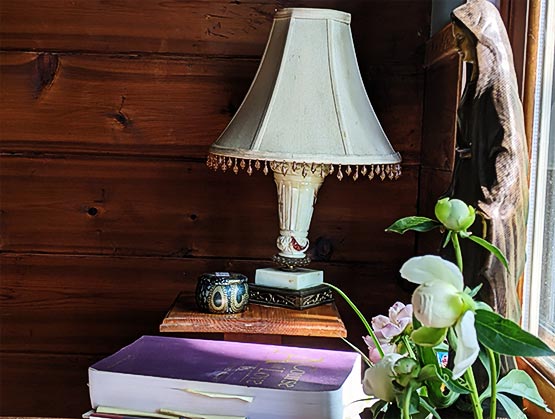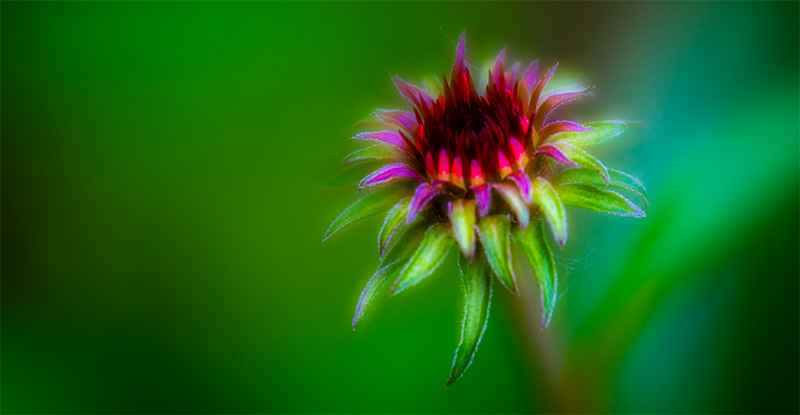Much of the country experienced a June heat wave. According to the Twin Cities National Weather Service, the first 13 days of June in the Twin Cities and much of Minnesota were the hottest on record.
This I knew. It took me longer to discover that this was a worldwide heatwave. From the Russian Arctic to Billings, Montana, Salt Lake City, Utah, and Palm Springs, records were set.
This morning it is a blessedly cool 67 degrees, but it’s early yet. Arriving in the cabin before five o’clock, I am greeted by another unusual occurrence: there isn’t a bit of darkness. The sky is, in fact, white. Just white. No variation. I wonder what that bodes, what it means weather-wise.
Looking out past my Virgin Mary shrine, Mary’s face takes a long while to come into view, and I find this is true even when the sky is white. But unlike much of the year, flowers have begun to bloom in the garden, and she is kept company, today, by peonies. 
When I was young, just about everyone in our neighborhood had peony bushes. The common wisdom that I carried into adulthood with me was that you couldn’t bring the peonies in too soon or they wouldn’t unfurl. They wouldn’t unfurl because they needed the ants to help them. The evidence was apparent each time a bouquet was picked. Holding the stems in your hand, you’d shake them, heads down, to remove ants before bringing them in the house. Then they’d go right to the sink where you’d put them in water and get the chance to wash the ants that emerged down the drain.
But this year, my husband, Donny, heard a peony expert say that this was a fallacy. Peonies could and should be picked as buds. I tried this, placing a half dozen buds in Mary’s shrine. I could hardly believe the sweetness it was to get to watch the buds unfurl over long, slow, days in the sun.
From this beginning, I began to imagine the babe in the womb, curled up securely, resting in the amniotic fluid. Like the water in a vase, the safe enclosure allows the petal appendages to become what they are to be: arms and legs, fingers and toes. Eyelashes.
As I imagine this cabin as my safe enclosure, I know many of us create these womb-like abodes where we, like the peonies, can adjust from being furled—or wound up tight. When we loosen up, we begin to bloom. Sometimes it takes a few hours, days, (or months) in such a dwelling to simply realize that you have been furled. At times we still need the human version of the pesky ants to start the process.
All it took to be able to watch this beautiful unfurling of my peonies was discovering that it was possible. I wasn’t going to take it at face value. But I saw for myself.
Whatever the process or the place we find, to inhabit ourselves fully, according to our nature—is the blooming of life and love and truth. Our potential arises from the nascent promise of our being.
[I]t is important to distinguish who you think you are from who you truly are. On the one hand, you think that you are your past, your shame, your guilt; on the other that you are your future, your glory, your potential. You neither want to share your most negative nor your most positive thoughts about yourself. These are your great secrets, the secrets that fill your mind day-to-day with thoughts that keep you from your Self.
And so there is just a small portion of yourself you share, the portion that your ego has deemed safe, acceptable, presentable. The portion that your ego has deemed will cause you no risk. It is the ego that asks: Are you certain that if you share that feeling, you will still be loved? Are you certain that if you reveal that secret, you will still be safe? Are you certain that if you try something new, you will still be accepted? . . . [W]hat you live is what you believe is the truth about yourself. While you continue to live dishonestly, your notion of what your identity truly is cannot improve. A Course of Love, C:31.15-16
If that is not an exact summary of how many of us feel, or have felt most of our lives, I’d be surprised.
In my new book, Mirari: The Way of the Marys, I was required to share more than the “safe, acceptable,” portion of myself. This surprised me, and many readers. I knew this disclosure could go one of two ways and I felt vulnerable. I wished for each friend who read “Mirari” in advance to “tell me the truth,” and if I was about to make a fool of myself. I cared about this for myself, of course, but I also didn’t want anything to detract from the impeccable nature of A Course of Love.
Now having published “Mirari,” I feel braver and truer, and buoyed by the number of deeply grateful responses I’ve received. I hope many of us will let our true identity unfurl. It is the start of everything.

